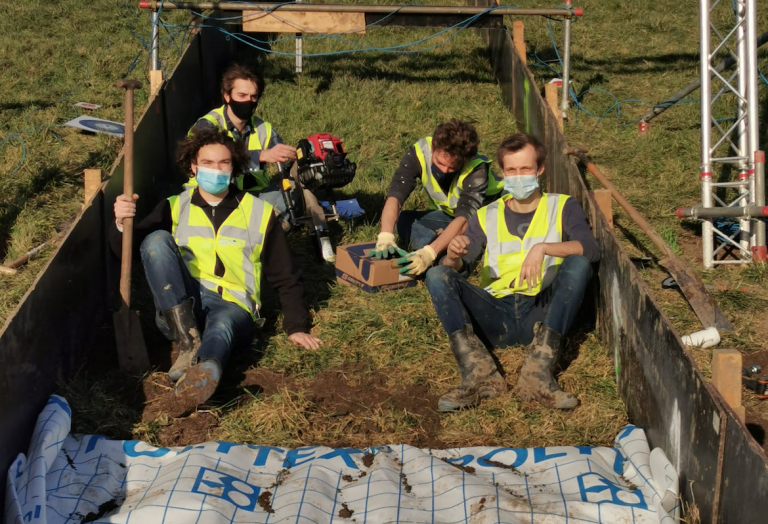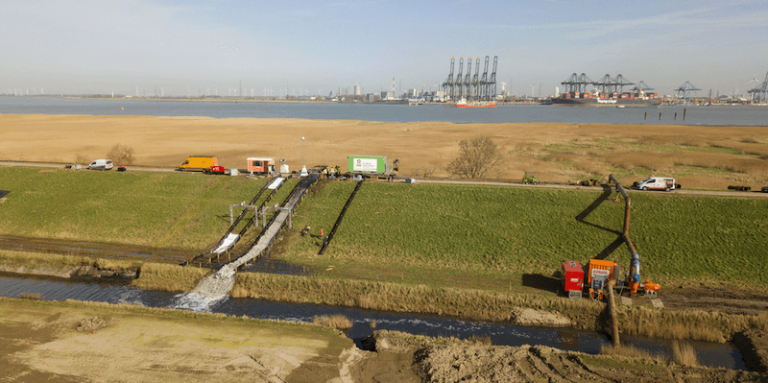Levee Challenge: educational, innovative and unique
- 15 April 2021
- Francien Horrevorts
- Knowledge Infrastructure
At the end of February, a very exciting event took place. Two teams of civil and hydraulic engineering students participated in the Levee Challenge in our Living Lab Hedwige-Prosperpolder. The challenge? To repair a damaged levee as well and efficiently as possible with surface protection measures. Let’s catch up with the organiser and student team leaders to learn a bit more.
The Levee Challenge
Glenn Strypsteen, postdoctoral researcher in the research group ‘Hydraulics and Geotechnics’ of KU Leuven Bruges Campus was the organiser of the challenge. He explains what activities the challenge included: “On the first day the teams prepared the levee strip of the other team by applying some serious damages. The teams had to remove 4 m² grass cover near the crest of the levee and create a 0.5-meter-deep cliff at the toe of the levee. Then the teams had to repair these damages within a timeframe of only 4 hours. On the second and third day the repairs were put to the test with intense water overflow.” explains Glenn.

TU Delft measure
The students had quite a different approach to the challenge. TU Delft’s repair measure was a temporary measure where they covered the damage on the levee locally. They used a water-repellent non-woven membrane and anchors to repair the damage. Maarten Buitelaar, team leader of the TU Delft team Hans Brinker about their solution: “The biggest challenge, of course, was to find the most suitable solution for the damaged levee, also fitting the given budget and facilities on the levee. For us, the challenge was to design an innovative and solid solution with advantages compared to the current methods, such as easier to install, applicable to all levees or not losing its strength over time.”
"The Levee Challenge in three words: educational, innovative and unique."
Maarten Buitelaar
KU Leuven measure
KU Leuven chose to use a more permanent solution, using woven coconut fibers in the form of a mat to cover the whole levee strip from crest to toe and anchors and sandbags to secure it. This was innovative as woven coconut fibers had never been used before for repairing levee damage. Jadon Beerlandt, team leader of KU Leuven team The Brugse Diek: “The most difficult part was ensuring that the coconut mat would not wash away, and the water could not reach the underlying damage. Therefore, we provided extra anchoring at the points where water could flow under the mat.”


Two different approaches
How would these different solutions compare? “Both methods cannot be compared, really.” says Jadon, “They both start from different objectives and ideals, which makes it perfect, actually”. We now literally see the difference between how engineers from KU Leuven and from TU Delft think. It is also very insightful to see the difference between a sustainable and non-sustainable method.”
For more detailed information about the repair measures of both teams, see their pitch videos.
Quality of repair measures
“It was interesting to see how these solutions were applied and also what the quality of the measures was. TU Delft needed less people and time, but both teams did an excellent job and made it in time. What is really unique is that the repairs would be put to the test during the following days.” Glenn says. On day two and three, the repair measures had to withstand intense water overflow. “The intensity of the water was increased from 350 to 700 l/s in the course of several hours. However, the repairs did not show any signs of extreme damage whatsoever. So, we manipulated the repairing solution by making a one-meter-long incision in the protection layer at the cliff. After another series of water overflow, on the TU Delft strip the grass roots were showing and some erosion occurred, specifically where the cliff was dug. On the levee strip of KU Leuven not much happened that was erosion related. These results were as expected.”

Valuable experience
The students look back on an interesting and valuable experience. Jadon: “It was wet, muddy but above all fun and very educational. It was truly a once-in-a-lifetime experience to be able to make up and implement something like this as a team. It was also a great activity in these times where getting out and seeing your friends isn't easy. It was good to see that after this difficult year we have not changed a lot and can still work together very well. I think each of us will often think back to this day.”
"Always bring fresh socks when you climb a levee. There is a good chance that you occasionally will lose your shoes on the way up."
Jadon Beerlandt
Maarten and his team also enjoyed the challenge immensely: “During the design phase of a suitable repair solution, we used a lot of knowledge we gained during our studies. During the test days on the levee, we mainly did a lot of practical work, something we have not done much of during our studies. This made the Levee Challenge a unique experience for our team. In addition, this event brought us into contact with a lot of colleagues. The knowledge you share is very useful and the contacts offer new opportunities.”
And the winner is...
And who is the winner? After both teams round up the Levee Challenge and their findings in a report and a promotional video, the winner will be announced. Three prizes will be awarded: one for innovative value, one for handling the available budget and a final prize for the promotional video. Who wins which prize is announced during a ceremony on the 21st of April.
